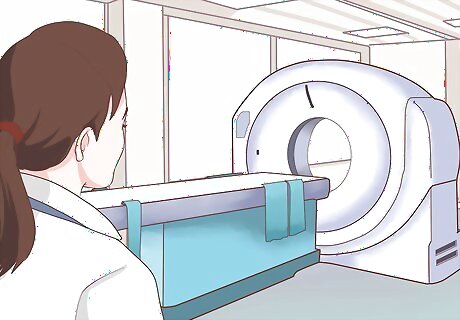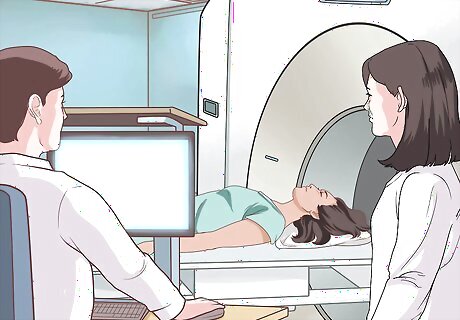
views
Adjusting the Environment

Ensure your physical comfort. Although you may be limited in how the specialist places you in the machine, be sure to position yourself in a way that is comfortable. Take any prescribed medications before your procedure, unless told otherwise by your physician, in order to avoid any discomfort.

Change the brightness of the lights in the room. Depending on your triggers, a darker or lighter room may make you feel more at ease. The correct ambience will put you at ease and make the time appear to go by quicker. Talk with the specialist/technologist and your physician about means to improve the environment in which the MRI imaging is taking place.

Alter the room’s temperature. Maintaining a comfortable temperature will limit your anxiety. Most hospitals or imaging centers should have blankets available if the room is too cold. A soft blanket will also add an extra layer of comfort.

Wear comfortable clothes. Depending on the procedure, an MRI scan can take anywhere from 15 to 90 minutes, so you will want to have on clothes that you can lay around in for a while. Do not wear tight or restrictive clothes, which may intensify your feelings of discomfort and possibly feelings of claustrophobia. Instead, wear clothes that are loose-fitting and allow for lots of air movement. If you are unsure what to wear, talk to the MRI specialist or your physician about appropriate clothing for your procedure. Avoid wearing clothes with any metal. You maybe asked to change into a hospital gown, which can increase anxiety, if your clothing is incompatible with the machine.

Use an MRI pillow. Because you have to be positioned a certain way during the MRI scan, there are a variety of different pillows created specifically for MRI procedures that will help you stay comfortable while you are in the imaging machine. Typically, the hospital or imaging center should have pillows available for you to use. However, if these pillows are unavailable, or you find them uncomfortable, talk with your physician or the imaging specialist about buying your own MRI pillow to bring to the procedure.
Staying Calm during the Scan

Utilize audio and visual aids. Familiar and relaxing media can sooth your fears and distract you from the noises of the MRI machine. The MRI machine can be noisy, increasing your anxiety, but soothing sounds and peaceful images can help you feel more relaxed and comfortable during the procedure. Ask ahead of time if the MRI suite has music you can listen to, or if you can bring a favorite CD and the staff can provide headphones. You will not be able to bring your own media device or headphones, as they contain metal that can interfere with the process. Some MRI machines have built in video screens that play relaxing images. Consult your doctor or imaging specialist to see if a machine with a video monitor is available.

Wear earplugs or noise cancelling headphones. The MRI scanner will make loud sounds during the procedure, which can be unsettling and anxiety inducing. Ask the MRI specialist if you can use a pair of earplugs or noise canceling headphones to wear during the procedure.

Try meditating. This practice helps promote relaxation through mental self-regulation. Meditation can take many forms and include different objects, such as prayer beads. Many practitioners repeat a “mantra” that helps them their mind, while others emphasize a prayer of other utterance.

Take deep breaths. Inhale and exhale slowly. Focus your mind on each breath.

Count to ten. Repeat as many times as necessary. Count to 20 if ten is too short.

Go to your “happy place.” Think of a location that you find particularly peaceful and relaxing. Visualize yourself in that space, emphasizing its details in your mind. This practice will help you mentally distance yourself from the MRI procedure and its accompanying anxiety.

Cover your eyes. Ask for a wet washcloth or an eye mask to set over your eyes before you begin. This prevents you from seeing your surroundings, which may trigger your claustrophobia or anxiety.

Follow your normal daily routine. It is important to maintain as many of your daily habits as possible the day of your procedure. This will help limit your anxiety going into your MRI scan. Eat your normal foods. Unless your physician tells you otherwise, you can eat normally the day of your scan. However, keep in mind that you cannot move during the scan so be sure to avoid foods that might cause gastronomic discomfort. Drink plenty of water; however, remember that you cannot take bathroom breaks during the scan and some procedures take as long as 90 minutes, so be sure to go to the bathroom before getting into the machine.

Get enough sleep. Being tired amplifies anxious feelings so it is important to get a good night’s rest before your MRI scan. Adults between the ages of 26 and 64 need seven to nine hours of sleep a night to ensure proper mental and physical health. Talk to your physician about taking a sleep aid the night before your procedure to ensure you are well-rested. However, keep in mind that many sleep aids may make you groggy and might not be compatible with other medications. Always talk with your doctor before taking new medications.
Getting Extra Help

Bring a friend or family member for support. They will help soothe you during the procedure by maintaining physical contact (holding your hand or touching foot). Be sure to bring someone who does not have a medical condition (pregnancy or metal implants in their body such as a pacemaker or aneurysm clip) that would prevent them from being in the imaging room. If friends or family members are unavailable, the hospital or imaging facility may supply a staff member to stay in the scan room with you. Communicate with the your friend/family member and the support staff during the procedure. This will help you feel more at ease and distract you during the procedure. There are speakers in the machine, as well as a call button or squeeze ball you can press or squeeze to communicate with the staff.

Take a sedative. With your health provider, discuss the possibility of taking a mild sedative before the procedure. Patients often find these types of medications relaxing and helpful in limiting anxiety. A prescription for the sedative will be required before the date of the appointment. Be sure to talk with your pharmacist about the medication and its side effects before the appointment. Because sedatives can make you tired or groggy, be sure to get a friend or family member to drive you to your appointment. Some imaging centers offer free transportation so be sure to make arrangements with the facility before your visit. Complete any important paperwork ahead of time due to the limiting effects of sedatives.

Contact a mental health professional. Consulting with a mental health professional may help alleviate your fears by addressing the underlying feelings and emotions. Your mental health provider may recommend practices or techniques designed to target the root causes of your anxiety.
Understanding the Procedure

Plan ahead. Talk with the hospital or imaging center staff about the procedure before the day of your appointment. Understanding what type of MRI machine you will be using, and the techniques associated with it, and visiting the hospital or imaging facility before your appointment can help you avoid any surprises on the day of your scan and make it a stress-free experience.

Talk with your physician. Discuss your medical history with your doctor to ensure that you do not have a condition that would prevent you from getting an MRI. Those who are pregnant or have a metal implant, such as a pacemaker, cannot receive an MRI.

See what the scanner looks like. If available at your location, ask the receptionist to schedule you in the open MRI. There are different imaging machines that are less restrictive, creating an environment less likely to induce claustrophobia. An Open High Field MRI has open sides and nothing holding you down. In an Open Upright MRI the patient sits or stands in the machine and there is nothing in front of their face. However, this machine produces less detailed scans and is less common.

Ask questions. Be sure to inquire about the length of the procedure and the steps involved in the MRI imaging process. Depending on the body part being imaged, you may not need to fully enter the MRI machine. For example, to acquire images of the knee, leg, or foot the patient only needs to insert their leg into the scanner tube - not their entire body.

Meet members of the imaging center or hospital staff. Patients generally experienced less anxiety if they met a staff member before their appointment. Calling for information may also be helpful if visiting the center is impractical.

Strategize plans for anxiety management during the procedure. Discussing the hospital or imaging center’s resources for making the experience more pleasant may alleviate your fears. The doctors and technologists may have tips and strategies that will help you feel more at ease.




















Comments
0 comment